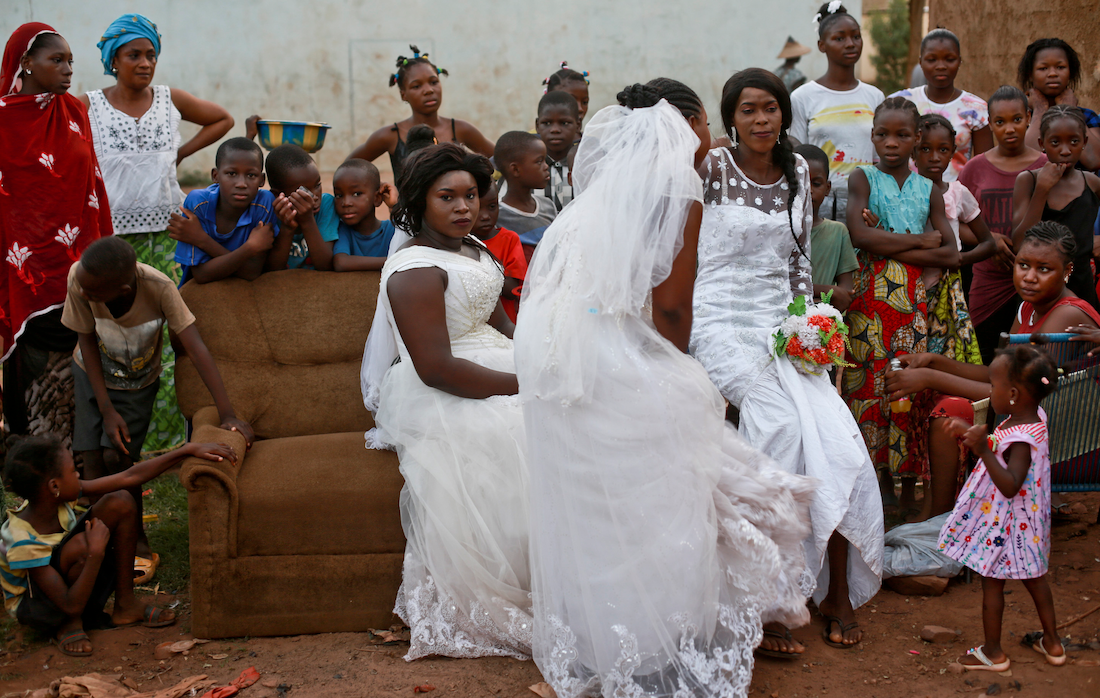
According to the international organization, UN Women, 35% of women in Mali have experienced sexual violence.1 In addition to this high rate, Malian women are further violated by an unspoken cultural norm called sutura, a tradition that psychologically grooms women and girls to conceal, forgive, and bear their sufferings in order to avoid a culturally-construed sense of shame. Sutura impacts how Malian society deals with sexual violence in a multitude of ways. For those with knowledge of an assault, empathy for the victim is expressed with silence and inaction. Victims themselves are required to protect their families from public shame by remaining silent. And not least at all, a victim’s anger towards her rapist is converted into empathy for fear of tarnishing his reputation and being marginalized for it. Victims of abuse are therefore expected to sacrifice their individual autonomy and rationalize their traumas, and taught to prioritize honor within their community over their own safety, desires, and justice.

The application of sutura reinforces Mali’s patriarchal society, wherein men hold primary power and dominate arenas of political leadership, moral authority, social privilege, and property ownership. The situation is severe enough to have earned Mali a ranking of 143rd out of 149 countries in the 2018 World Economic Forum’s Gender Gap Report.2 Unfortunately, this is not a new development. In 2008, it was published in The New Humanitarian that incidents of rape were reported every four days in Bamako. And yet, between January and October of 2008, only six men were convicted of rape and sentenced to jail.3
In this context, sutura can be understood as a systemic tool that protects the patrilineal reputation.
Under it, women must be adept in its practice and in its education among younger generations, otherwise they are ostracized, deemed illegitimate and unworthy. In a quest to shatter the restrictive cultural norms that govern women in Mali, the exhibition Musow Ka Touma Sera presents work from six Malian women artists, who hail from the four corners of the country and who are leaving their mark on the male-dominated world of Malian photography. Together, we examine sutura and the subcultural mechanisms which enable patriarchy—and counter them with a message of empowerment to Malian women.

Kani Sissoko centers her series Affliction on the African traditional religious rituals commonly referred to as black magic and known for their use of cosmology, symbolism, and art. These rituals are often practiced in the woods and involve animals, trees, and blood, which are believed to deliver practitioners from life’s troubles. These elements of mysticism exist in Malian subcultures and are frequently incorporated into daily life. In the development of her series, Sissoko noted a visual similarity in the marks left by humans on trees’ barks during rituals and the wounds suffered by women and girls as a result of sexual violence. Affliction paints an abstract representation of Malian women and the pain that they seek to drown through mysticism. Sissoko invites women to stand up to the harsh reality of their shared pain—not just by challenging rituals of abuse, but also the common rituals of relief that fail to prevent the cycle of violence.

While traveling from Mali to neighboring countries, Amsatou Diallo was drawn to sites of worship and noticed the abundant presence of women within them. This sparked the creation of her body of work entitled Refuge de Femmes (Women’s Refuge), a series of photo-collages which combines symbolic colors with images of women in religious attire layered upon photographs of landmark cathedrals and mosques. Diallo omits the distinctive facial features of these women in an effort to suggest that their individuality is often sacrificed to religious expectations. Her use of neutral colors and hues of red evokes the tensions of allegiance between religious devotion and free will, as women are frequently hindered by expectations of forgiveness and deference to God, which requires them to accept societal injustices occurring at their expense.

Originally from Tombouctou, Fatoumata Diallo was raised in a family of semi-nomads who settled in the Nara Cercle, which is located at the border of Mauritania and is home to Soninké, Bambara, Maure, and Fula cultures. Surrounded by women from multiple cross-sections of Nara, Diallo quickly developed a fascination with their traditional necklaces, which are individually crafted according to tribe, age, marital and social status, and worn around the city of Dina. The necklaces, known locally as la parure, are an important cultural artifact that were historically used to identify tribal affiliation or summon spiritual energy to facilitate procreation. Diallo’s series La Parure is a bittersweet effort to juxtapose their past and present use. While the necklaces are important in the history and development of Malian arts and crafts, they now primarily function as a signifier of women’s social standing and the gender-based financial dependencies that often render them as property of their husbands. In this regard, La Parure reflects the tension between women’s socio-cultural identities and personal independence.

L’Afrique en Mode Yougou Yougou (Africa in the yougou yougou Fashion), the youth-centered body of work by artist Fanta Diarra, studies the second-hand clothing that is coveted for its affordability and cosmopolitan fashions and is exported to Mali from different parts of the world. For decades, yougou yougou—which in Bambara is a pejorative term for old and deteriorated items—has invaded local markets, taking businesses out of operation. Additionally, the unsanitary conditions in which the clothes are shipped pose a threat to public health, specifically that of women and children. In Diarra’s mission to convince fellow Africans to support local retailers, the viewer is presented with a deceptively warm depiction of joyful young women sporting these imported fashions, seemingly unaware of or indifferent to their negative impact on Malian society. Diarra frames the material excess of yougou yougou as an expression of continued colonial hierarchies, ones that many Malians perpetuate at a great economic and social cost, so long as it improves their social status.

Fatoumata Diabaté titles her latest series À chacun son dimanche (To each their sunday) in reference to the world-renowned song “Dimanche à Bamako” by musician couple Amadou & Mariam, which celebrates Sundays as a popular wedding day in the city. The selected photographs examine the diverse ways in which women approach their day of matrimony. “The hopeful” shows a bride in a stream of white light which seemingly reflects her desires for the future. By contrast, “the realist” claims her space with confidence, often looking squarely at the camera and shown in plain, even light. Finally, “the rebel” is shown walking away, dressed in traditional attire reserved for the wedding night when a bride is taken to her husband’s home for the first time. While there is beauty in the wedding traditions, clothing, and festivities, Diabaté also makes use of a sotrama car (a common mode of transportation and a symbol of community that is infamous for its reckless chauffeurs) to suggest the irreverent approach many women have towards choosing their life partners.
Such irreverence is troubling considering that one in two women in Mali, regardless of marital status, is a victim of intimate partner violence (IPV)4 and that the conversation around this form of abuse is taboo.

The series of photographs presented by Oumou Traoré are part of a research project initiated by the Centre for African Studies at the University of Basel. Titled Construire Son Avenir (To Build One’s Future), the Centre’s project aims to understand how university graduates in Mali and other African countries deal with uncertainty in regards to their professional achievement, and how they negotiate their ambitions in societies that are heavily influenced by traditional expectations around gender roles.5 Within the scope of this research, Traoré’s series presents related conflicts between traditionalism, economic uncertainty, and the ambition of contemporary youth. Traoré brings Malian domestic life into focus by juxtaposing an old-fashioned TV with a hanging tapestry that depicts a group of women carrying children on their backs while cooking a meal together. In a different photograph, Traoré presents another unconventional pairing: an image of a traditional African wax print emblazoned with a scroll that reads, “Economic Growth and Women’s Autonomy, Inclusive Engagement for a Safe, Stable and Emerging Mali.”
These images capture the tension many youths feel between maintaining cultural identity and pursuing their dreams, which often requires them to challenge existing gender roles.
Other images in the series (one of a diploma, another of a hand-written biography) reference the importance of educational attainment to women’s independence, which is rarely achieved because over 50% of adolescent girls in Mali are forced into early marriage.6 This practice shields families from potential social shame by ensuring that pregnancies happen within wedlock—yet another example of how sutura is applied. It is often correlated with IPV and early childbirth. The result makes it nearly impossible for girls and young women to pursue educational and professional opportunities which might render them economically independent. Despite this economic uncertainty and gender inequality, the Centre’s research concludes that youth in Mali maintain high aspirations for their futures, and that projects fostering self-expression, such as Traoré’s, increase the possibility of professional success and self-actualization as they counter existing social hierarchies.7

If we acknowledge that the application of sutura has reinforced patriarchy in Mali and has contributed to gender-based violence and profound social inequality, we must also acknowledge that the solution to our society’s ills is feminism in its universal and simplistic definition, without ambiguity or cultural relativism. And as counter-intuitive as it may feel given the standard social conventions to which we are accustomed, our duty as Malian women must now shift away from fear, that of losing our dignity, dishonoring our families, and speaking out. Instead, we need to reclaim our personal autonomy in order to close the gender gap, and foster a new kind of sisterhood: one that seizes a power to collectively change the tradition passed on to younger generations, and support the youth in their unshivered search of equality.
Together, we can ensure that womanhood is no longer about suffering, but rather about coming together despite adversity to fight for justice and equality.
Fatima Bocoum
Open Call Exhibition
© apexart 2019
1. “Prevalence Data on Different Forms of Violence against Women,” UN Women, accessed October 15, 2019, http://evaw-global-database.unwomen.org/en/countries/africa/mali.
2. The World Economic Forum, The Global Gender Gap Report 2018, 2018 http://www3.weforum.org/docs/WEF_GGGR_2018.pdf.
3. “Violence against women on the rise,” The New Humanitarian, October 2, 2008, http://www.thenewhumanitarian.org/report/80716/mali-violence-against-women-rise.
4. Brittany Hayes and Carlijn Van Baak, “Risk Factors of Physical and Sexual Abuse for Women in Mali: Findings from a Nationally Representative Sample,” Violence Against Women, 23, 2016.
5. Centre for African Studies Basel, Construire son Avenir, January 2017, http://longingforthefuture.ch/de/research-background/construire-son-avenir.
6. The World Economic Forum.
7. Centre for African Studies Basel.

